One hundred and twenty nine kilometers northeast of Colombo lies Kandy. Historically known as Sri Lanka’s “hilly city,” Kandy is easily accessed by car via the Colombo-Kandy Road. Kandy, once known as Senkadagalapura, served as the last capital of Sri Lanka’s last independent monarchy that endured for almost 400 years until succumbing to British rule in 1815.
Unlike the island’s west coast cities, Kandy withstood dozens of attempted invasions carried out by Portuguese and Dutch colonists whose goal was to dissolve its monarchy and exploit its resources.
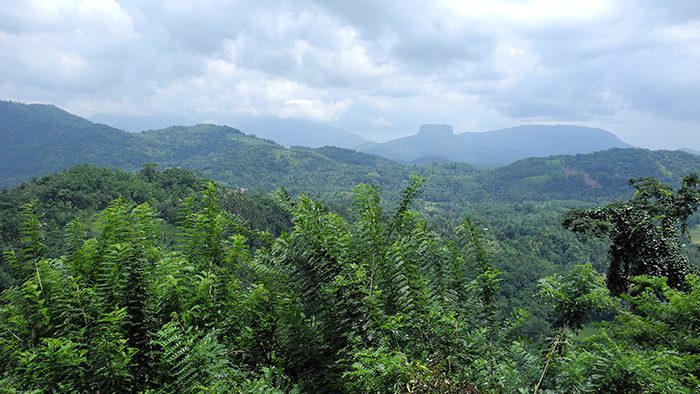
Kandy is now Sri Lanka’s second largest city and is home to the Sacred Temple of the Tooth Relic, one of the holiest places of worship for Buddhists throughout the world.
The Sacred City of Kandy was deemed a UNESCO World Heritage Site in 1988 and continues to be of great religious and cultural importance. Kandy is also home to Peradenya, the Royal Botanical Garden that was designed by the British in 1843.
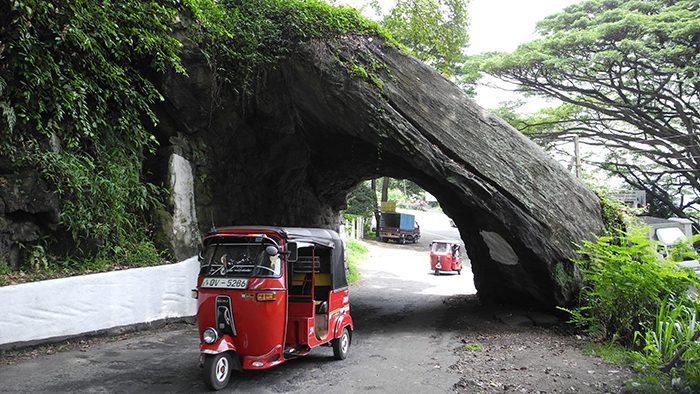
Sprawling over 150 acres, it is the largest botanical garden on the island and renowned for its striking orchid collection. Perfectly manicured lawns, indigenous trees, shrubs, and fountains are found throughout the space. Wace Park (also known as Wales Park in honor of the Prince of Wales) is another public outdoor space located atop a small hill overlooking Kandy Lake.
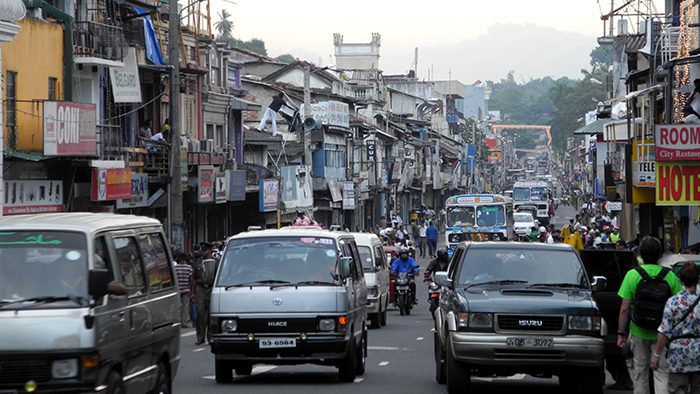
In addition to hosting hundreds of Buddhist pilgrims every year, Kandy has also become a popular destination with tourists since it is just a two-hour drive from Colombo.
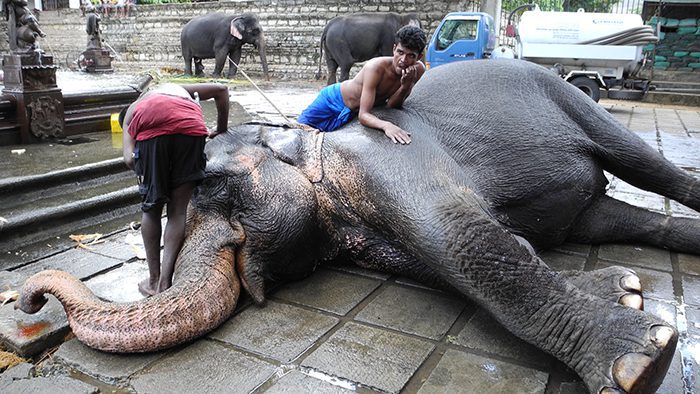
Lush forests, valleys, rivers, mountains, lakes, and waterfalls are all found nearby, which gives Kandy the unique advantage of having natural beauty. The countryside scenery and Buddhist culture, as well as the availability and quality of handcrafted souvenirs, draw in thousands of visitors each year. Here are 5 things to see in Kandy!
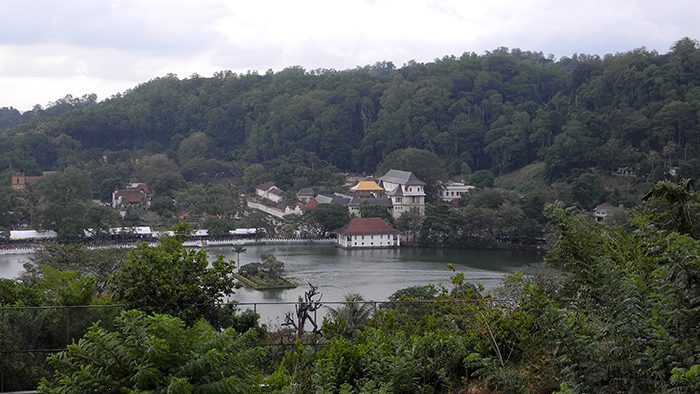
Arguably the highest point in Kandy, Arthur Seat is a lookout point southwest of Kandy Lake, just past the Royal Palace Park. Hail a taxi or tuk-tuk to the top of the hill for stunning panoramic views of Kandy. Straight past the wooden sign at the edge of the hill, you will spot Kandy Lake. To the left, you will see the White Buddha monument, and miles of sprawling hillsides just beyond where you stand. A great photo op, as you may have gathered.
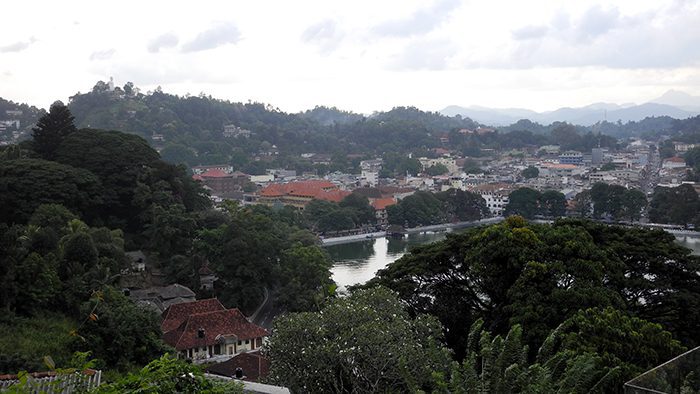
Arthur Seat was named after Arthur C. Clarke, a British author and inventor, whose notable work includes 2001: A Space Odyssey. He lived in Colombo’s prestigious Cinnamon Gardens neighborhood for years before passing away in 2008. The Arthur Seat area is replete with street vendors selling arts and crafts. They can be quite persistent in their attempt to sell you wooden Buddhas, postcards, or books. Most are willing to negotiate prices, but I suggest purchasing trinkets from one of the many professional handicraft manufacturers in and around Kandy.
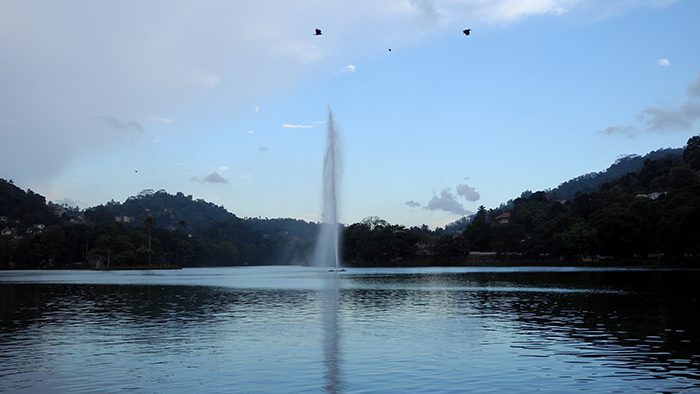
Kandy Lake was created in 1807 by the last Sinhalese King, Sri Wickrama Rajasinghe. As the main body of water in the hilly city, it is said that the lake’s construction sparked controversy from the very beginning. The king’s advisors opposed his decision to excavate rice paddies in order to create a purely decorative lake during a time that European forces threatened the future of the Kandyan Kingdom.
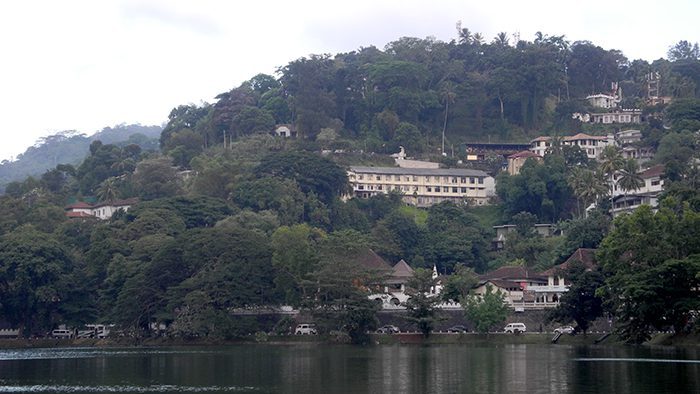
In true monarchal fashion, the lake was finished to the king’s liking and still remains in the center of the city for all to enjoy. The lake’s perimeter is about 3.2 kilometers and it is encircled by a 628-meter-long walakulu (decorative wall). The walakulu remains unfinished because British forces took over the kingdom in 1815.
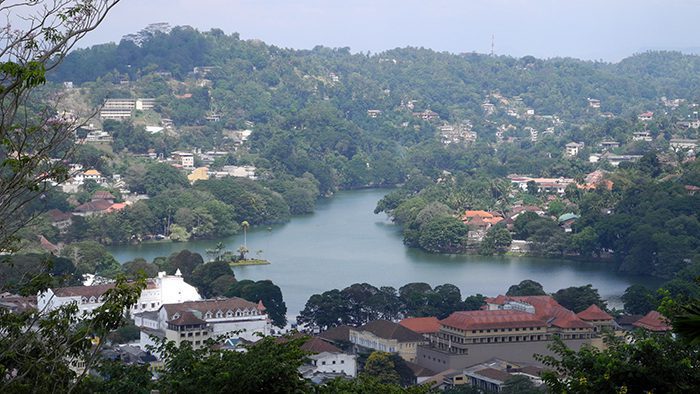
While walking around Kandy Lake you will notice an island in its center. Many believe this land mass was connected to the royal palace via underwater tunnels. Others believe it was used as the sleeping quarters for the royal harem and that the king would often visit his ladies by boat. The royal bathhouse, or Queen’s Bath, is located along the perimeter of the lake across from the royal complex.
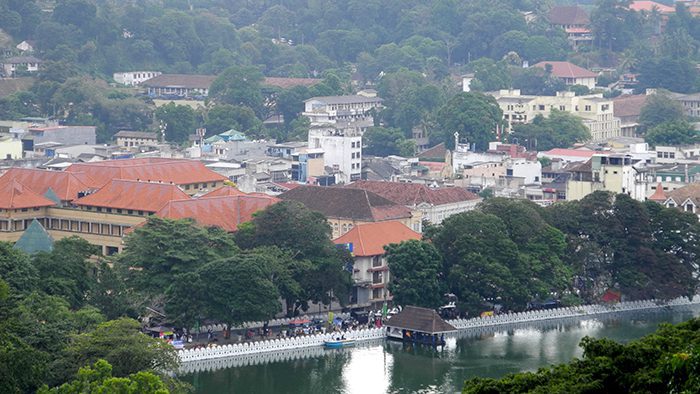
It is where the king’s women, both wives and concubines, bathed. The Sacred Temple of the Tooth Relic is located on the north side of Kandy Lake. Both sites can easily be seen back to back in one afternoon. Swimming in Kandy Lake is banned and the area is mostly used for walking tours and scenic photography.

The 243-meter-high gleaming White Buddha monument has stood watch over Kandy since being constructed in 1993. The concrete Buddha is perched high atop a steep hill and is visible from nearly everywhere in the city. The monument is part of the Bahirawakanda Temple. Not surprisingly, the temple was relatively under the radar before the monument was erected.

Many visitors opt out of the 20-minute brisk climb to the top even though it offers views of Kandy Lake and the surrounding hillsides. The Bahirawakanda Temple is not as admired as the Temple of the Sacred Tooth Relic, but is still a significant place of worship for Buddhists. If you are not in the mood for the uphill climb, we suggest admiring the White Buddha comfortably from the ground.
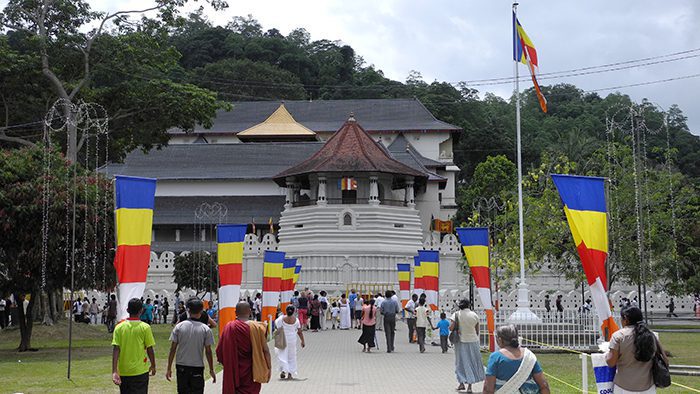
The Sacred Temple of the Tooth Relic, or “Temple of the Tooth” for short, is a significant part of the Royal Complex and the city’s most popular tourist attraction. Located in the city center along the banks of Kandy Lake, the temple contains a canine from Buddha, making it one of the most significant Buddhist pilgrimage sites in Sri Lanka.
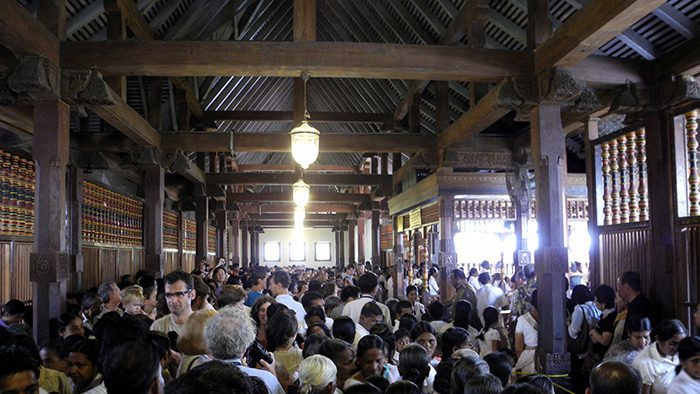
The tooth itself is said to have been taken from the funeral pyre of the deceased Buddha. It is believed that the tooth was smuggled into Sri Lanka by Princess Hemamali and her husband Prince Dantha. It was believed that whoever possessed the tooth relic had the right to rule and it was a monarch’s responsibility to safeguard the sacred tooth relic and prevent it from falling into the wrong hands. The Kandyan Kingdom was the last monarchy in Sri Lanka and so the tooth remains in Kandy to this day.
Check out What to See in Yala National Park

Nowadays, the Temple of the Tooth Relic is surrounded by other buildings in the Royal Complex. These include the old courts building, the Royal Palace, the National Museum, the New Palace, the Queen’s Bath, and the Octagon. Architectural elements of the Royal Complex include ornately carved pillars and ivory doors.

The temple’s interior features wooden inlays, ivory carvings, and a gold ceiling that was donated by the Japanese government. The tooth relic is safely enshrined within seven bejeweled golden caskets atop a throne. Admission is $9.

The yearly Esala Perahera, or Tooth Relic Festival, is held each year in late July and early August. For anyone lucky enough to be in Kandy during the festivities, the celebration is a cultural delight. This ten-day parade holds events each evening and attracts hundreds of Sri Lankan Buddhists and tourists alike.

Every evening the procession begins at the Sacred Temple of the Tooth Relic and winds its way through the streets of Kandy. Bleachers are erected along sidewalks and street corners to accommodate spectators, but many attendees stand as the entertainment parades along. Kandy hosts approximately one million pilgrims during this time.
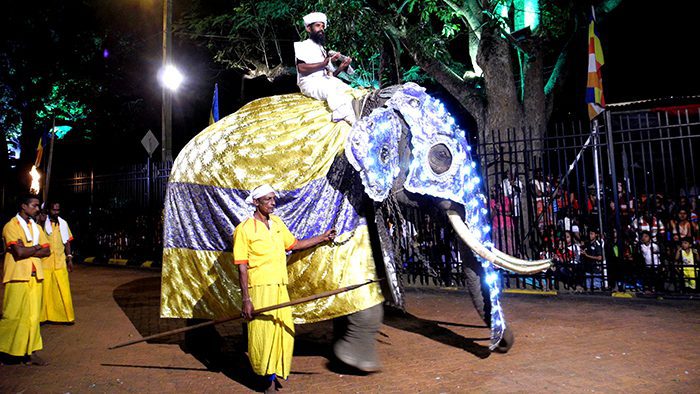
More than one hundred elephants are dressed up in ornate, lighted costumes and led through the streets. Men wearing white robes tap drums and shake tambourines, as fire dancers dazzle the crowd. Jugglers, acrobats, and noblemen also join the procession in commemoration of the tooth relic and its four guardian deities: Vishnu, Natha, Kataragama, and Pattini.
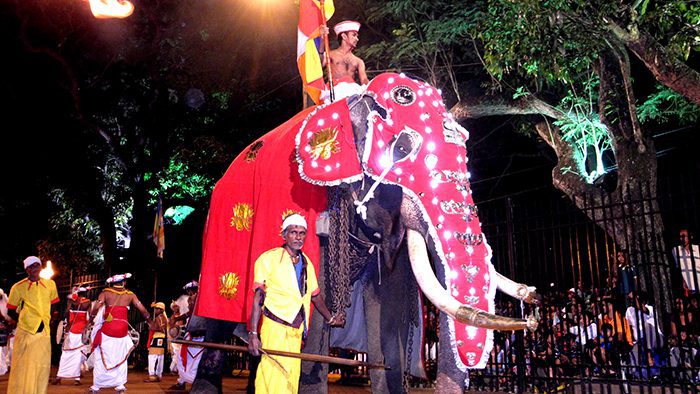
The festival has been a tradition since the 18th century, and is one of Sri Lanka’s most significant cultural and spiritual events. Flags from various provinces are waved proudly, as they represent the former sectors of the Kandyan Kingdom.

The last male elephant in the procession is the one that holds the gilded tooth relic casket. The actual tooth is never taken out of its shrine at the temple, and has not been paraded through the streets since 1990 when Kandyan officials decided that the tooth should never be moved.
Check out the Top 12 Things to See and Do in Colombo

You do not have to be a follower of Buddhism to enjoy Esala Perahera. Dozens of Christians and Muslims from Sri Lanka arrive in Kandy to partake in the festivities, regardless of their differing religious beliefs. If you visit just before festival time, you can watch as the elephants get washed and groomed in front of the Royal Complex. Their keepers feed and bathe them out in the open in preparation for the festival. These are the best-dressed elephants you will likely see and they are a source of joy and pride for Kandyans.
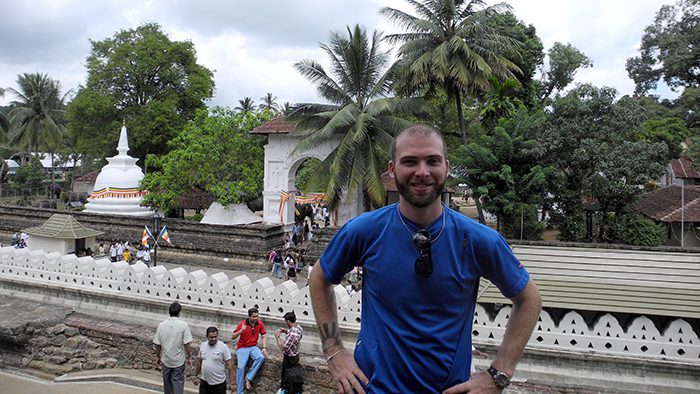
Kandy is an unforgettable slice of Sri Lankan history. I was lucky enough to be visiting during the Esala Perahera Festival in 2011, so I was able to experience a true wonder of Buddhist culture. The procession of dancers, musicians, and elephants is both spiritual and enchanting. If you’re planning to visit during this time, be sure to book your hotel room well in advance.
The people in Kandy are hardworking and friendly. Everybody is trying to make a living, and in a country where nearly twenty percent of the people are impoverished, it is no wonder why vendors and “tour guides” are always popping up to show you the way. Stick to your guns and don’t be afraid to say “no thank you” to anything you do not want. Be sure you always know where you are going and have a plan. Other than that, feel free to mingle amongst snake charmers, fruit vendors, and acrobats. Tip when warranted and enjoy yourself.
There is little to no nightlife in Kandy, and although there are a couple of options after dusk, most people stay in. The history of the area is also incredibly interesting. The Kandyan Kingdom held its ground against European invasion longer than any other on the island. Perhaps it was the miles of hills that the Europeans couldn’t conquer…or maybe it was divine intervention from the ancient tooth relic.
Don’t forget to pay Oak Ray Wood Carvings a visit. The craftsmanship is top notch and the pieces are outstanding. So the next time you are in Sri Lanka make sure to visit the capital city of the last of the Ceylon Kingdoms and check out these 5 things to see in Kandy!
Time zone: GMT +5:30 hours (Indian Standard Time)
Capital city: Colombo
Languages spoken: Sinhalese, Tamalese and English
Currency: Sri Lankan rupee (LKR)
Currency converter: XE
Getting around: When traveling between cities, buses and trains are best. Buses can be really crowded and are seldom air-conditioned. Though trains are slower and can be crowded as well, they often considered the more comfortable mode of transportation. When in the city, tuk-tuks, buses, taxis, and, in many cases, simply walking, are all viable forms of transportation. In some cases, cars and drivers can be hired for a day or bicycles can be rented.
Shopping: Kandyan craftsmen are renowned throughout the island for their aptitude, and at Oak Ray Wood Carvings (9 Deveni Rajasinghe Mawatha) visitors can purchase top quality wooden decorative items. Whether you are looking to buy or just looking out of curiosity, Oak Ray is sure to delight and inspire your inner decorator. Oak Ray’s shop puts your neighborhood furniture shop to shame with its extensive selection and traditional techniques used to engrave, cut, grind, and polish. Various woods are used to produce the beautiful pieces on display. Ebony, teak, mahogany, jack, oak, and coconut wood are just some of the materials used in the crafting of the Oak Ray’s statues, masks, furniture, sculptures, and trinkets. Prices are negotiable. There is no need to worry about flying back with your new items. Oak Ray conveniently arranges international shipping directly to your home. Neighbors will gawk when the new family heirloom arrives at your door.
Tipping policy: Service fees, typically 10%, are included at most restaurants. Drivers and guides will also expect tips. A tip of 50 LKR is acceptable for hotel doormen and the people who collect guests’ shoes at the temple.
Electricity: There are two types of sockets, the Type D Indian 5 amp BS-546 and the European CEE 7/16 Europlug.
Entry/exit requirements: As of January 1, 2012, all holiday and business travelers to Sri Lanka must have an Electronic Travel Authorization (ETA). This can be obtained online through the Sri Lanka Electronic Travel Authorization System website.
Health and safety: Though cases are rare, dengue fever is endemic to Sri Lanka. The mosquito-borne illness, though treatable, has potential to be fatal. The only way to prevent contracting the dengue virus is by avoiding getting bitten by mosquitoes. Use a reliable cream or spray insect repellent to keep mosquitoes at bay and sleep under a mosquito net whenever possible. Symptoms usually begin four to seven days after being bitten by an infected mosquito. Seek medical treatment if you think you have dengue fever. Adequate emergency medical treatment in private hospitals can be expensive. It is advisable to have travel health insurance coverage during your stay. We recommend the Explorer package by World Nomads. To avoid unwanted attention, refrain from displays of wealth including wearing expensive jewelry and producing large amounts of cash.
Best time to go: Sri Lanka has two monsoon seasons, which means that planning your trip does require some pre-planning. The dry season in the south western area of the country is between December and March. The dry season in the northern and eastern sections of the country last from May to September. Between October and November, sporadic rains occur throughout the country. December through March is then both the most popular and the driest time to visit.
Because of Kandy’s elevation, its rainiest months are May to July and December to January. Therefore, planning a visit anytime between January and April will be your best bet for optimal weather conditions. Additionally, Kandy experiences 70% to 80% humidity throughout the year.
Did you enjoy our article of the 5 things to see in Kandy? Leave us a question or comment below!
Counter
101 Countries • 1432 Cities
Manahara Maharathmalathanne says:
Next time you visit Rathnapura ,Mathale, Nuwaraeliya, Kegalle So many Nice moments there.
David says:
will do!